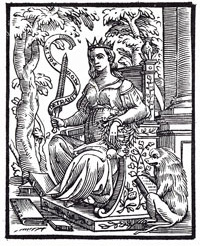Academia
'Academia', from Cesare Ripa, Iconologia (1630)
 The illustration of ‘ACADEMIA’ on this webpage is taken from the 1630 edition of Cesare Ripa’s famous Iconologia, which was first published in Rome in 1593. Initially Ripa's book included no illustrations and the first set of woodcuts were added in 1603. The 1630 version included yet more pictures, including that of ‘ACADEMIA’. In this case the iconography itself was also new, it was the contribution of the editor, Giovanni Zaratino Castellino.
The illustration of ‘ACADEMIA’ on this webpage is taken from the 1630 edition of Cesare Ripa’s famous Iconologia, which was first published in Rome in 1593. Initially Ripa's book included no illustrations and the first set of woodcuts were added in 1603. The 1630 version included yet more pictures, including that of ‘ACADEMIA’. In this case the iconography itself was also new, it was the contribution of the editor, Giovanni Zaratino Castellino.
The 1709 London edition gave the following brief summary of Castellino’s elucidation of the moral emblem of ‘ACADEMY’:
A Lady of a manly heroic Aspect, having a Crown of Gold, a particolur’d Garment, a File in her right Hand, and a Garland in her left. Her masculine Countenance denotes solid and Profound Judgment; the Crown of pure Gold, the refining of Notions by Experiments; the various Colours, the variety of Sciences in an Academy; the File, the polishing of pieces, and freeing them from Superfluities; the Garland, Honour to those who excel.
The motto around the file says ‘Detrahit Atque Polit’ (i.e. ‘It Removes and Polishes’). The garland at the left hand of ‘ACADEMIA’ is made up of laurel, ivy and myrtle, the plants of Apollo, Bacchus and Venus, and pomegranates, the symbol of a group brought together out of common preoccupations.
Behind the throne of ‘ACADEMIA’ is seated a bearded ape, or baboon, the symbol of letters, the animal consecrated to Mercury, the inventor of arts and letters. The ape is also a symbol for the equinox, a measurement of time (the academician must measure the hours carefully, spending most of them in study), and for imitation (the beginning of learning, according to Aristotle).
